The pace of globalization, despite its critics around the world, continues unabated. This reality raises increasingly pressing management issues for multinationals engaged in today’s complex and rapidly changing environment.
A key challenge within this context emerges from doing business across regions and national boundaries. To prepare for continued success and growth internationally, companies need to equip their managers with an awareness and knowledge about differences between national cultures. Despite an increasingly cross-border business world, the emergence of “culture-free” business practices has yet to materialize; in fact, the complexities associated with differing beliefs and practices remain distinct challenges in spite of the growing interdependence among countries.
One feature of today’s global business environment is clear: Cultural differences persist and influence business outcomes. Therefore, as organizations extend their geographical reach, several key questions can help initiate the journey of exploring and developing intercultural cooperation in a business context.
- How do multinational companies develop cultural competency and acknowledge cultural values as a factor in creating a synergy between individual insight, regional needs, and the different parts of the company to support strategic business imperatives?
- When does the process of building the culturally competent organization begin?
- What steps compose an effective cultural-orientations approach that encompasses building the skills, tools, and support mechanisms that organizations/managers need to succeed?
Decoding the Cultural Dimension
The scope and impact of culture on international management practice are broad and bring to the forefront a number of critical issues that face many global organizations. From a cultural-differences perspective, today’s effective global manager must be able to deal with
- Defusing the strain between a strong corporate-headquarters mindset and the realities of the local marketplace.
- Sensitizing managers to cultural differences when interacting across national boundaries in a virtual matrix structure.
- Leveraging the leadership and organizational-change potential of managing diversity and inclusion within a global workforce.
- Capturing creativity and innovation from the cross-fertilization of ideas across national boundaries.
- Managing learning about how cultural differences impact the shifting of major organizational processes offshore, such as outsourcing.
These and many similar issues elevate the importance of building cultural competence. As a culturally competent organization, companies can be responsive, agile, and adaptable in recognizing and responding to these issues while controlling more proactively their ability to compete globally on several crucial levels:
- Individual level—enabling individual employees, managers, and leaders to operate effectively in the ambiguity, uncertainty, and complexity of a culturally diverse employee, customer, and supplier base and geographically dispersed matrix relationships.
- Team level—enabling a team or work group to integrate new talent; leverage knowledge and skill resources effectively; engage its stakeholders; develop and sustain effective and inclusive operating practices; and adapt to change.
- Business-unit/functional level—enabling the bridging of cultural gaps and the effective exchange of knowledge, creating compatible business processes and practices and developing synergies between functional business cultures as well as customers and suppliers.
- Organization level—enabling the organization to adapt and develop its culture strategically to the changing performance and talent requirements of the global marketplace.
Appreciating the Impact of Culture
Cultural Boundaries Are Not National Boundaries. The concept of cultural boundaries is often used interchangeably with those of geographical and political boundaries (i.e., the nation). This notion has served well those businesses that divided the world into neat geographic regions and serviced them with a multinational organizational structure—a perspective no longer attuned to the realities of the global workplace.
Culture Is a Shared Pattern of Ideas, Emotions, and Behaviors. Culture operates on both a conscious and subconscious level; at both a group and individual level. It is useful to think of culture as an iceberg (Fig. 1). The tip of the iceberg symbolizes the level of behavior and other observables/tangibles (i.e., the world of manifestations). Beneath the level of our daily awareness, this behavior is linked to a world of values that is shared by a group. This internal world, which consists of ideas and their emotional value, is symbolically expressed as the bottom of the iceberg.
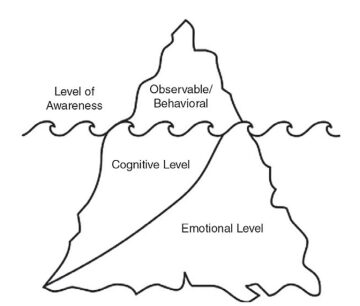
In simplistic terms, the shared linkage between a behavioral expression (a handshake or a bow) and an idea or notion constitutes a norm. If we observe, for example, that a particular group of people tends to shake hands upon meeting, we may call this behavior the social norm for this group. The shared linkage between an idea/notion and an emotion can be considered a value.
The connection between norms and values is recognized by defining culture as the complex pattern of ideas, emotions, and observable/symbolic manifestations (including behaviors, practices, institutions, and artifacts) that tends to be expected, reinforced, and rewarded by and within a particular group.
Building Cultural Competence
Cultural competence is, therefore, an increasingly important characteristic defining a successful global manager. Whether one is relocating to a different country, on a temporary assignment, part of a regional or global team, or leading a regional or global project, the ability to transcend cultural differences in the pursuit of business objectives is a critical skill set.

How Do Cultural Differences Affect Work and Management Practices? It is difficult to provide a succinct overview of all the aspects of culture that affect work and management practices. Generally, individual value orientations and social norms do influence the behaviors of leaders, managers, and employees. TMC has developed the Cultural Orientations Model, composed of 10 dimensions that exert an influence on work behavior and management practice: environment, time, action, communication, space, power, individualism, competitiveness, structure, and thinking (Fig. 2). The model is embedded in a five-step skill-building process that begins critically with open-mindedness to differences, a willingness to change, and a desire to enhance one’s skills and abilities (Fig. 3).
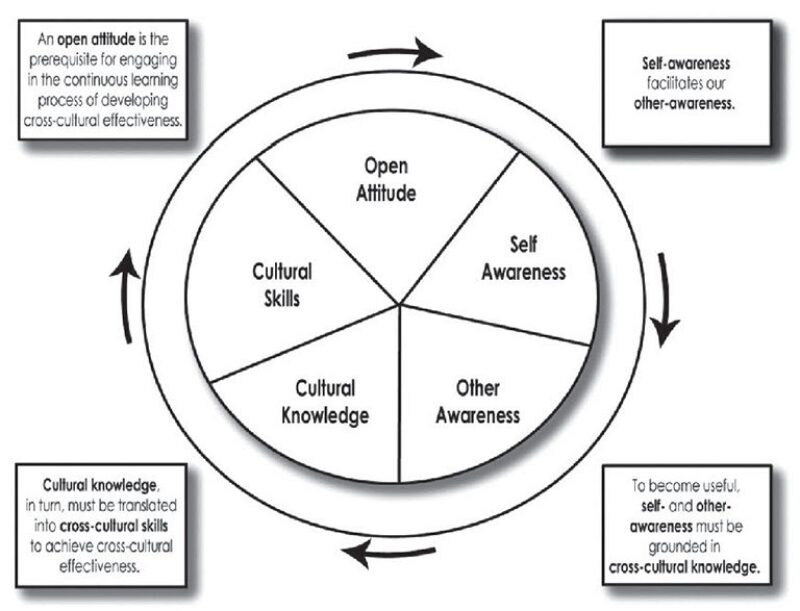
Through this learning process, global managers can acquire and deploy a cultural skills set, as an essential part of their managerial toolkit, composed of four key skills.
- Cultural due diligence—the practice of assessing and preparing for the possible impact of culture.
- Style switching—the ability to use a broad and flexible behavioral repertoire in order to accomplish one’s goals.
- Cultural dialogue—the ability to elicit cultural information through conversation, and thereby clarify cultural underpinnings of behavior and performance, close cultural gaps, and create cultural synergy.
- Cultural mentoring—the ability to facilitate cultural understanding and integration to a new and different cultural environment.
Doing Business in India and China
The degree to which culture can impact managerial effectiveness is best illustrated by highlighting the challenges of working with colleagues and partners from specific countries, such as India and China, two of the world’s fastest-burgeoning economies. As each country is undergoing momentous change, it is important to remember that their cultures seek continuity, underscoring the need to be patient in developing and nurturing links and relationships in India and China.
As these countries turn their attention to strengthening their ability to compete in the global economy, they face a new challenge—developing international expertise and gaining exposure to the developed world. In particular, they must acquire the skills and tools to lead and manage people in order to interact effectively with their counterparts from around the world. Similar challenges face all that aspire, in turn, to do business with India and China (i.e., getting firsthand knowledge about the cultures and business contexts of these countries).
The contrasts of culture are no better shown than in the interactions that American or Northern European managers have with their counterparts in these two countries. Critical insights can be gained by reviewing the core cultural values of these countries and the impact these values have on interpersonal interactions and management practice.
To avoid stereotypes, a starting point may be to access the Cultural Navigator, a TMC Web-based learning resource, to review general country information as well as evaluate the cultural norms of India and China. To build on this background and create an appreciation of the complexity for cultural differences that influence the conduct of business across national boundaries, consider four perspectives that expose how our mindset needs to change while revealing the intricacies facing us (Fig. 4).

Gap Analysis. By comparing country-to-country background data, we can discover where there may be gaps or “social distance” among national cultural norms. Cultural gaps are important in that they may represent barriers preventing the trust and confidence essential to relationship building.
By applying the skills of cultural due diligence and style switching from the managerial toolkit described above, we can begin to effectively close the gaps between differences in cultural orientations. Opening one’s mindset to new possibilities (i.e., viewing the world differently or adjusting management practice on the basis of differences in cultural values) is a critical choice in building cultural competence.
Using the gap-analysis tool can reveal potential differences along the dimensions of the Cultural Orientations Model and stimulate critical awareness. For example, the contrast between fixed and fluid orientations to time, if not acknowledged, can lead to frustration, impatience, and organizational ineffectiveness. In the case of India and China, consider what the cultural differences are, what potential conflicts might arise, and how we can use cultural knowledge to resolve these gaps or differences.
United States—Fixed
- Time is defined precisely.
- View good time management as a critical professional attribute.
- Make frequent reference to time and time constraints.
China—Fluid
- Must balance demands of deadlines against the importance of building strong relationships.
India—Fluid
- Define time loosely and generously.
- Know foreigners are punctual; make concerted efforts to be on time.
Potential Conflict (from a U.S. perspective)
One’s preference may lead to frustration and lower productivity. You may
- Be perceived as rigid and inflexible.
- Reject tasks that would change your plans, and thus appear uncommitted to overall goals.
- Become irritated when plans and tasks take longer than expected.
Resolution (from a U.S. perspective)
It is critical to bridge this gap and adapt one’s style.
- Try to see time as relative rather than absolute.
- Develop patience for business situations that are dictated by a fluid time orientation.
- Build in flexibility when scheduling and establishing timelines.
Value Differences
An equally critical step is to consider the fundamental differences in cultural values and mindsets from an Indian and Chinese perspective as well as how these differences can impact business interactions. It is evident that Chinese and Indian business networks are noticeably sustained by cultural values and tradition. When these values disappear, the networks collapse and successful business relationships can be seriously, if not irreparably, compromised.
As within any culture, values vary across national boundaries, and their interpretation on the local scene can be complex and nuanced. To illustrate the significance of values, two key cultural values have been identified as representations of the Chinese and Indian cultures.
• Relations, connections [Guangxi (Mandarin) in China; Rishtaa (Hindi) in India]. A person is defined not so much as an individual, but rather as members of families and social networks. Family members have primary relationship status, friends and close colleagues have secondary status, and business associates and acquaintances rank third. In Indian society, for example, the value of self-identity and community membership, shared with a partner or colleague, remains a central life experience.
Implications for western managers: Social networks are the basis on which trust is established, reciprocated, and developed. Trust is an essential characteristic of social networks and therefore must be established before any serious business relationship can be cemented. Business relationships based on personal trust will endure greater stress and demonstrate greater adaptability. Developing relationships built on connections among counterparts may take more time to mature than in the West and require considerable patience and flexibility.
Mindset Change: Focus on developing relationships and building trust before and during business transactions and interactions. Tasks are accomplished once trust is established.
• Face, honor [mianzi/lian (Mandarin) in China; Izat (Hindi) in India]. A sense of dignity and honor that is maintained in their social networks. Instead of “saving face” or rescuing others from embarrassment, one tends to think in terms of giving and getting face. There are a myriad of ways to give “face,” such as accepting business cards properly, addressing people by their surnames and titles, and hosting meals for others. Losing face occurs through the actions of others, i.e., when one is criticized, reprimanded, or made fun of.
Implications for western managers: “Face” is a concept of central importance because of its universal influence in interpersonal relations for Chinese and Indians. “Loss of face” makes it impossible for the individual to function properly within the business or social community of which they are a part; colleagues or partners will no longer have confidence in the persons or companies concerned.
Mindset Change: “Saving face” and protecting one’s “honor” are guidelines affecting all successful professional and personal interactions in China and India. The key is to “save” the other person’s “face” and “honor” at least as much as one’s own, if not more.
While these values may have their counterpart in Western societies, the significance of the differences is important, and there need to be fully understood when working closely with Indians and Chinese. Value differences influence the way we behave, think, manage, and work with others from different cultural backgrounds.
Management Practice Differences
Understanding value differences leads to a better appreciation for the nuance and influence of culture on business interaction. Taking our exploration a step further, consider the impact that culture exerts on managerial practice. This can be illustrated by comparing a representative list of six managerial competencies selected from more than 20 commonly recognized managerial competencies (Table 1).
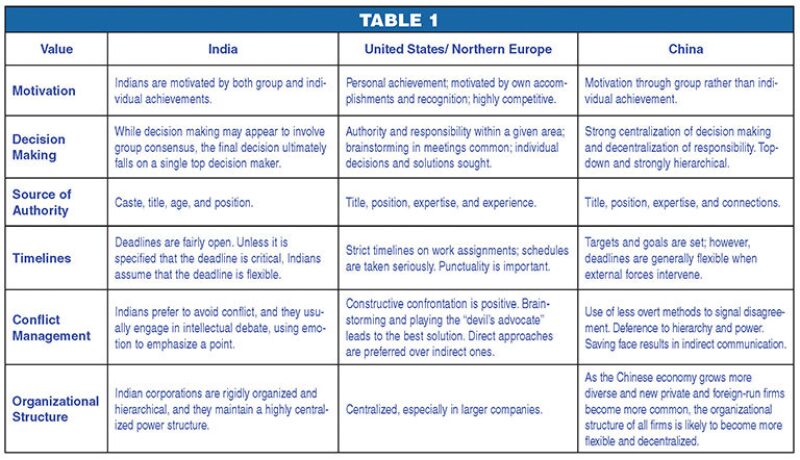
Through comparisons of this kind, the implication of values gaps/differences or social distance becomes clearer in terms of the potential impact on business interactions. In turn, an in-depth awareness and knowledge of each national culture and its cultural values can enhance the individual’s and organization’s ability to build stronger interpersonal relationships when dealing across national boundaries.
Analyzing Culture Clashes. Drawing upon country-specific knowledge, a variety of comparative-analyses data sets, and one’s cultural skill set, a manager is now better equipped to approach a specific country cultural circumstance with heightened understanding and confidence. In the scenarios that follow, one can apply one’s cultural toolkit to resolve day-to-day intercultural work situations for increased efficiency and productivity. How do you think you would address these cases?
India
You receive a call from one of the Indian Alphacorp managers who was involved in contract negotiations several months ago. She indicated her dissatisfaction, but she did not elaborate on any specific concerns. Although you have moved to a different position and new responsibilities, you checked with the technical experts and the implementation team. You find out that everything was delivered and installed according to Alphacorp’s specifications. Recent testing indicated superior systems performance. How can you resolve this issue? (Fig. 5).
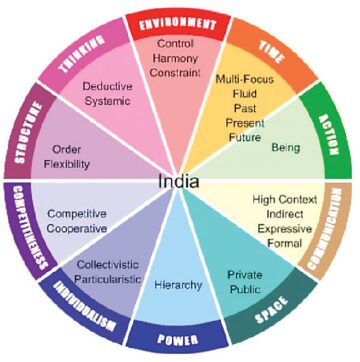
Solution: The best approach to resolving this situation would be to schedule a visit with your successor at Alphacorp, to explore the source of the client’s dissatisfaction.
Analysis: This scenario demonstrates a gap between being and doing orientations in the context of a project. Alphacorp is a being-oriented, or relationship-centered, organization. As such, it is important for its managers to establish strong, trusting relationships between employees as the foundation for business transactions. It is very likely that the source of dissatisfaction is that you have moved into a different position, and a trusting relationship has not yet been established with your successor. Sending a technical expert cannot adequately substitute for this loss. Rather, transferring the relationship to your successor through a joint visit to Alphacorp will give this being-oriented customer needed assurance.
China
On the basis of your success at the U.S. headquarters as a sales manager, you are sent to China to oversee the creation of a new department. You are fluent in both Mandarin and Cantonese, so verbal and written communication is not a problem. During your first meeting with the new department, you discuss in detail and in Mandarin your motivation and interest in making this department one of your organization’s top business units. You tell them about an incentive program you have created that will allow each member to excel and be rewarded for individual contributions. You make decisions and implement changes you feel will help you achieve this goal. After a few days, it becomes apparent that your Chinese subordinates are not enthusiastic about your plans. Why are they upset? (Fig 6).
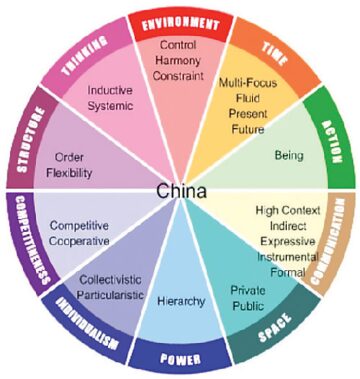
Solution: The Chinese would prefer to be treated as a group and not receive individual recognition for contributions.
Analysis: It is inaccurately assumed that the competitiveness used as motivation and incentives for sales forces in the U.S. will have the same impact with members of a Chinese sales force. Such an approach will be unpopular with the Chinese for at least two reasons: The culture is much more cooperative in nature than in the U.S., using established networks to accomplish goals, and the Chinese would prefer group recognition to having individuals excel.
As these two scenarios show, cultural awareness and understanding differences in cultural norms and values are crucial elements of a global manager’s skill set. Cultural competence enables both the organization on a strategic level and a manager or team on a tactical level to resolve issues and compete in today’s complex cross-border marketplace. Without cultural competence, what are the implications of remaining unaware of the impact social distance or gaps might have in these situations? What repercussions may result if the gaps between managers andteams persist?
Cultures in Transition—The Challenge Going Forward
Building cultural competence is a multifaceted process accelerated by the day-to-day reality of working across national boundaries. Indian and Chinese management culture is in a time of transition—on a local level, cultural values and norms continue to exert a strong influence, while on an international level, the influences of globalization, technology, and Western management practices have increased over the past decades. While China and India push to acquire knowledge of, exposure to, and experience in Western management practices, their counterparts around the world seek market penetration and business growth in these countries.
The degree to which Indian and Chinese management systems change, and the speed of that change, are at the crux of the debate about transition. Regardless of the pace of change, it is important to appreciate that traditional cultural values, such as the concept of hierarchy, the nature of social and community networks, the implication of continuity and stability, and a prevalence for flexibility and ambiguity, continue to impact managerial practice and remain influential features of the cross-cultural management landscape.
For managers and organizations doing business in India and China, a clear appreciation of individual and national cultural values and norms is essential—be it for the Western expatriate manager in India/China or his/her country counterpart engaged in outsourcing or offshoring activities with the West or as a leader of a multicultural virtual team. While work circumstances do not always reflect cultural differences, evidence shows that issues of this nature are an inevitable thread in the fabric of management practice and personal interaction.
While intimidating and frustrating at times, the good news is that cultural challenges are manageable by acknowledging cultural gaps openly and resolving them cooperatively by using available cultural knowledge, country information, and personal dialogue to develop core cultural competence skills to sharpen one’s mindset for the global marketplace.
In this issue of TWA, which highlights India and China, we are pleased to include an article on the influence of culture on competing in the global market. The article provides tips on how to build a culturally competent organization. It describes how culture affects the way in which companies do business in today’s global market and also presents insight into the similarities and differences in the values, culture, and management practices of India and China compared to other regions. Armed with the knowledge gained from reading this article, you will be well on your way to building a high-performance team that is part of a culturally competent organization.
Natalie Pestana, TWA Interim Soft Skills Editor


